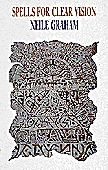


|
Spells for Clear Vision.
Neile Graham.
London, ON: Brick Books, 1994. 85pp, paper, $11.95.
ISBN 0-919626-74-2
Grades 11 - 13 / Ages 15 - Adult.
Review by Liam C. Rodrigues.
|
excerpt:
``Crow Girl"
Some one must remember her name,
this girl who fills the land surrounding her.
It is certain she does. Though they're hidden
under the blanket wrapped around her,
she has sure hands. She knows the plain,
has made it into herself. It shapes her
like the grass she stands in:
blades drying, it readies itself for
snow. Rising like the white man's house
behind her, but steady and lasting
as the earth beneath her hidden feet.
 Spells for Clear Vision is Neile Graham's second volume of
poetry. Divided into four sections, this collection seems like a
hodge-podge at first glance. Although this initial impression is
essentially accurate, the book shouldn't be dismissed outright.
Spells is formally un-centred, and sometimes guilty of
sacrificing stylistic unity to exploration, but this is quickly forgotten
in the overall effect.
Spells for Clear Vision is Neile Graham's second volume of
poetry. Divided into four sections, this collection seems like a
hodge-podge at first glance. Although this initial impression is
essentially accurate, the book shouldn't be dismissed outright.
Spells is formally un-centred, and sometimes guilty of
sacrificing stylistic unity to exploration, but this is quickly forgotten
in the overall effect.
Where other collections aspire to a cohesion that is somehow visible
among the poems themselves, Spells is not so much project of unified
poems as of unified action. The title suggests something magical within,
and the poems do cast spells -- not of incantation, but of consequence;
not of recipe and formula, but of affect and transformation.
Diverse in its influences and subjects, Spells often
leaves the reader seeking connections. But don't try too hard; the
collection, as the first poem points out, is ``a maze," designed to
mislead its audience. To experience the charm of Graham's poetry you must
submit to its creative deceptions. As she herself suggests, her poems are
an ether; the dragon's breath that veils the mythological forces that
drive human action from the empirical world in which we think we live.
Consequently, although Spells is couched in mysticism,
it is also the poetry of everyday life, and a celebration of the magical
forces therein. ``I believe in the common magic of forests and household
gods," the narrator of the final poem explains, and this is the key to
appreciating what Graham has been trying to do all along.
Spells is a mystery that is indecipherable until the end,
but like all good mysteries, its outcome, though withheld, is
inevitable.
So form and tradition, homage and allusion, are scarce; it is the
words themselves that matter. ``Transcribe my stories to settle around
you," she instructs, directing us to our own lives for the images and
inspiration that give meaning to these poems. In ``The Grass She Stands
In," for example, from the first section of Spells, sea
glass, photographs, and postcards represent the age; these are the
artifacts that mark our existence, the spells we have cast. Graham is
most effective in the ``Five Crow Poems" of this first section. If few of
the poems in the following sections have this haunting, holographic
quality, Spells for Clear Vision remains a worthwhile, if
challenging, work for senior students.
Recommended.
Liam C. Rodrigues is a Toronto-area writer interested in art,
architecture, poetry, and all that liberal arts stuff.
To comment on this title or this review, send mail to cmeditor@mts.net

Copyright © 1995 the Manitoba Library Association.
Reproduction for personal use is permitted only if this copyright notice
is maintained. Any other reproduction is prohibited without permission.
Published by
The Manitoba Library Association
ISSN 1201-9364
 Go back to CM Welcome page
Go back to CM Welcome page
 Go back to Table of Contents for this Issue
Go back to Table of Contents for this Issue



 Spells for Clear Vision is Neile Graham's second volume of
poetry. Divided into four sections, this collection seems like a
hodge-podge at first glance. Although this initial impression is
essentially accurate, the book shouldn't be dismissed outright.
Spells is formally un-centred, and sometimes guilty of
sacrificing stylistic unity to exploration, but this is quickly forgotten
in the overall effect.
Spells for Clear Vision is Neile Graham's second volume of
poetry. Divided into four sections, this collection seems like a
hodge-podge at first glance. Although this initial impression is
essentially accurate, the book shouldn't be dismissed outright.
Spells is formally un-centred, and sometimes guilty of
sacrificing stylistic unity to exploration, but this is quickly forgotten
in the overall effect.![]()
 Go back to CM Welcome page
Go back to CM Welcome page Go back to Table of Contents for this Issue
Go back to Table of Contents for this Issue